By Da Yin, KubeVela Maintainer
Since Open Application Model invented in 2020, KubeVela has experienced tens of version changes and evolves advanced features towards modern application delivery. Recently, KubeVela has proposed to become a CNCF incubation project and delivered several public talks in the community. As a memorandum, this article will look back into the starting points and give a comprehensive introduction to the state of KubeVela in 2022.
KubeVela is a modern software platform that makes delivering and operating applications across today's hybrid, multi-cloud environments easier, faster and more reliable. It has three main features:
KubeVela cares the whole lifecycle of the applications, including both the Day-1 Delivery and the Day-2 Operating stages. It is able to connect with a wide range of Continuous Integration tools, like Jenkins or GitLab CI, and help users deliver and operate applications across hybrid environments.
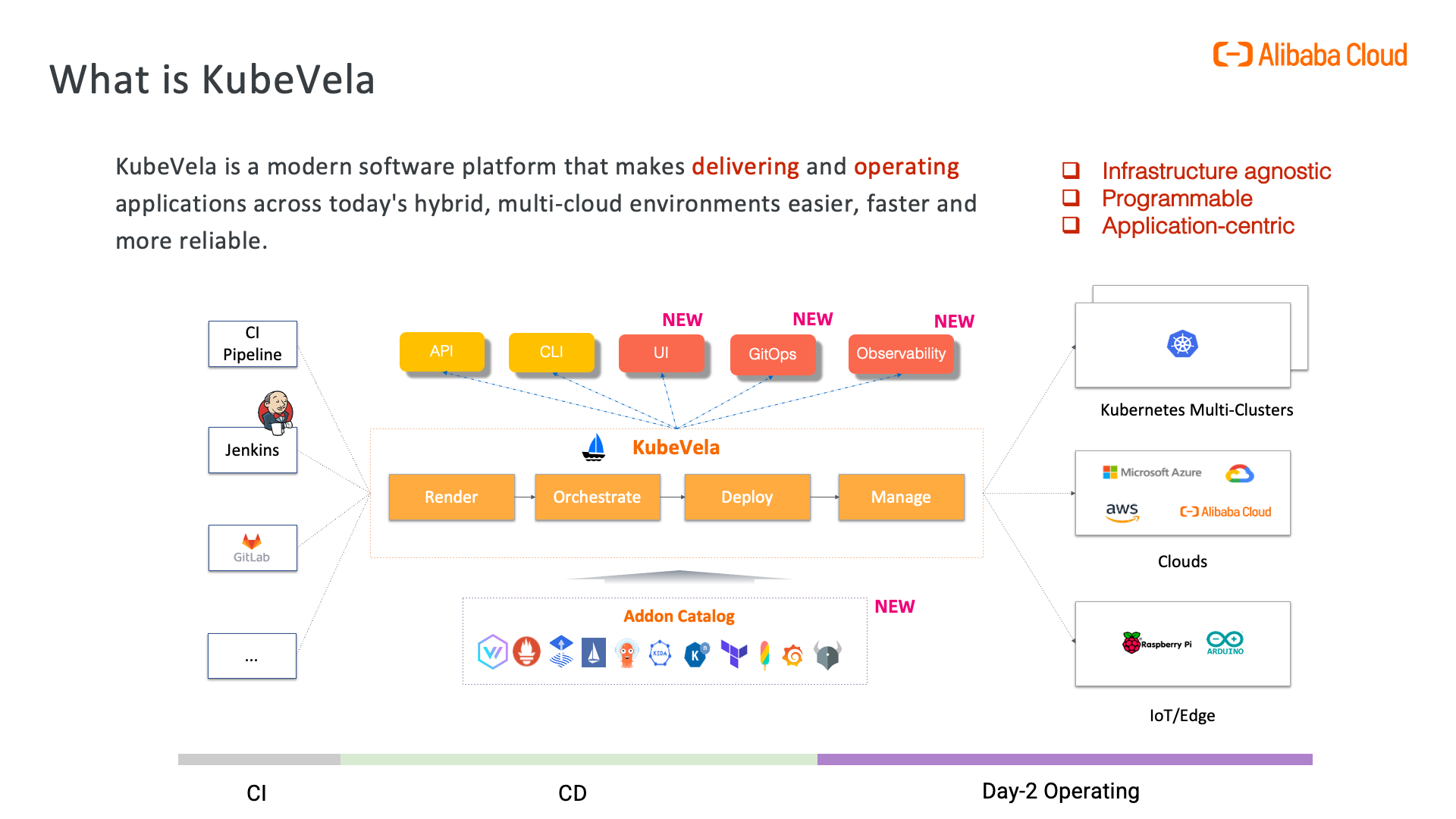
Nowadays, the fast growing of the cloud native infrastructures has given more and more capabilities for users to deploying applications, such as High Availability and Security, but also exposes an increase number of complexities directly to application developers. For example, the Ingress resource on Kubernetes enables users to expose their applications easily, but developers need to handle the Ingress upgrades when the underlying Kubernetes version shifts, which requires knowledges for the Ingress resource. The hybrid deployment across various cloud provides can make this problem even harder. These difficulties are caused by the lack of operational input in the application definition and developers must face the infrastructure details directly if they want to enjoy the benefits brought by the rich cloud-native community.
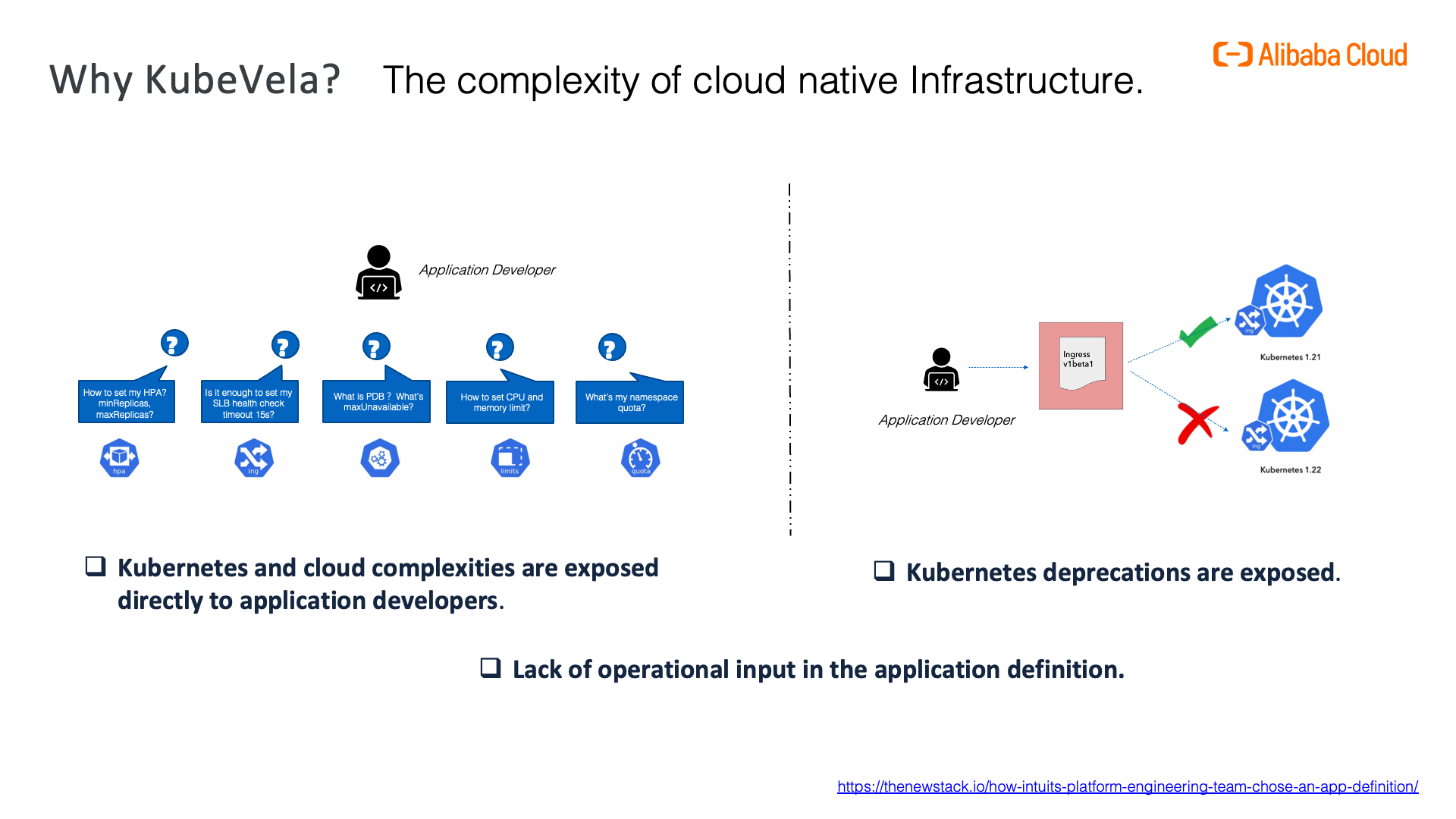
To tackle the above challenges and bridge the gap between the use of applications and the understanding of infrasturcture details, Open Application Model (OAM) is jointly proposed by Alibaba Cloud and Microsoft Azure in 2020. The aim is to define a consistent application model for application delivery, irrelevant with the platforms and implementations. The defined application model describes an interface for developers on what an application consists of and how it should work. The former one is known as Component in OAM, which is usually used to model the workloads of the application. The latter one is defined as Trait in OAM, which attaches extra capabilities to Components.
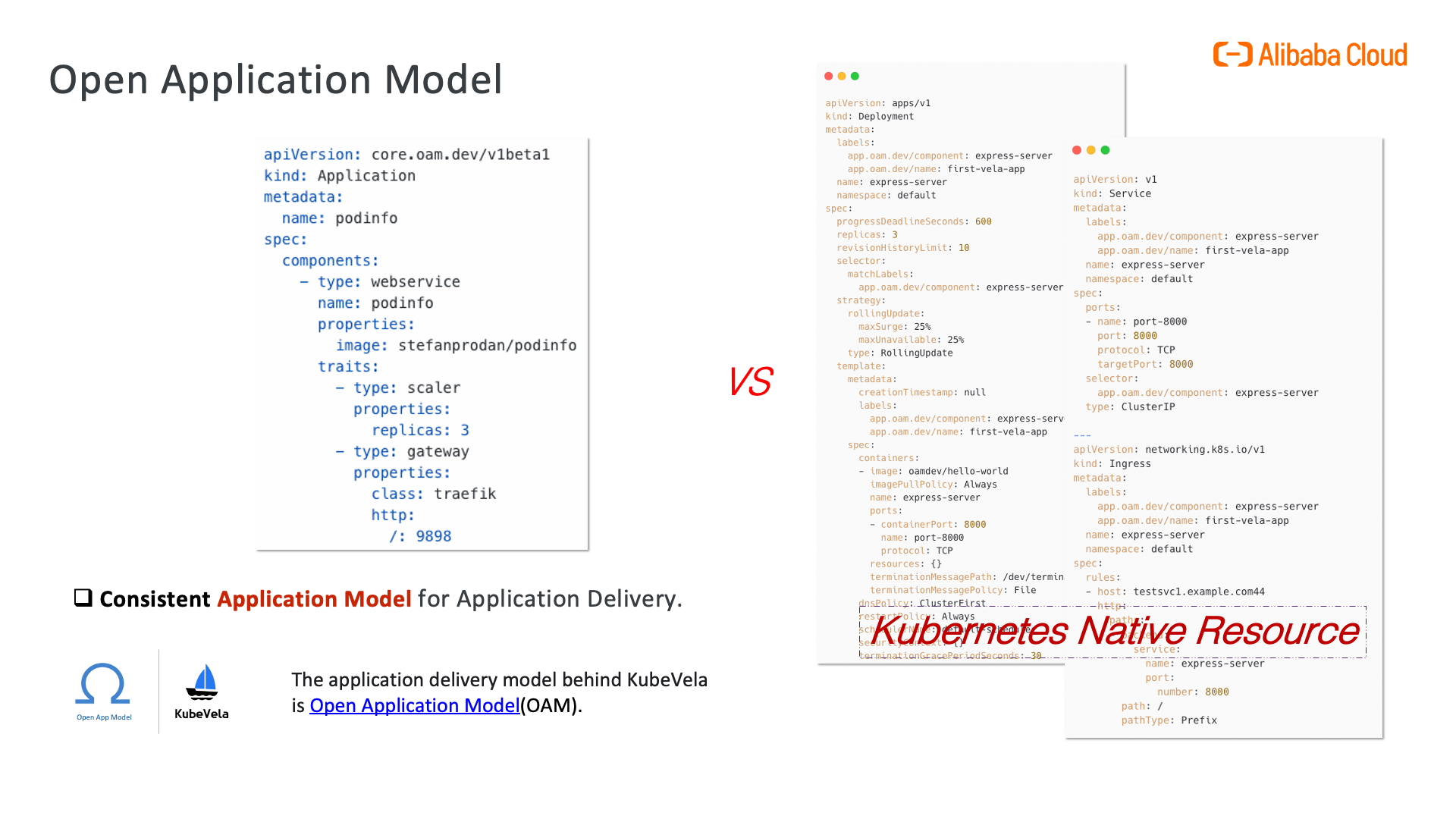
KubeVela is one of the implementations for the Open Application Model. In KubeVela, the abstraction layer is powered by CUE, a novel configuration programming language which can describe complex rendering logics and work as a superset of JSON. The abstraction layer simplifies the configuration of resources in Kubernetes, which hides the details of implementations and exposes limited parameters to the front developers. With KubeVela application, it is easy for developers to focus on the centric logic of applications, like what container image should be used and how the service should be made accessible.
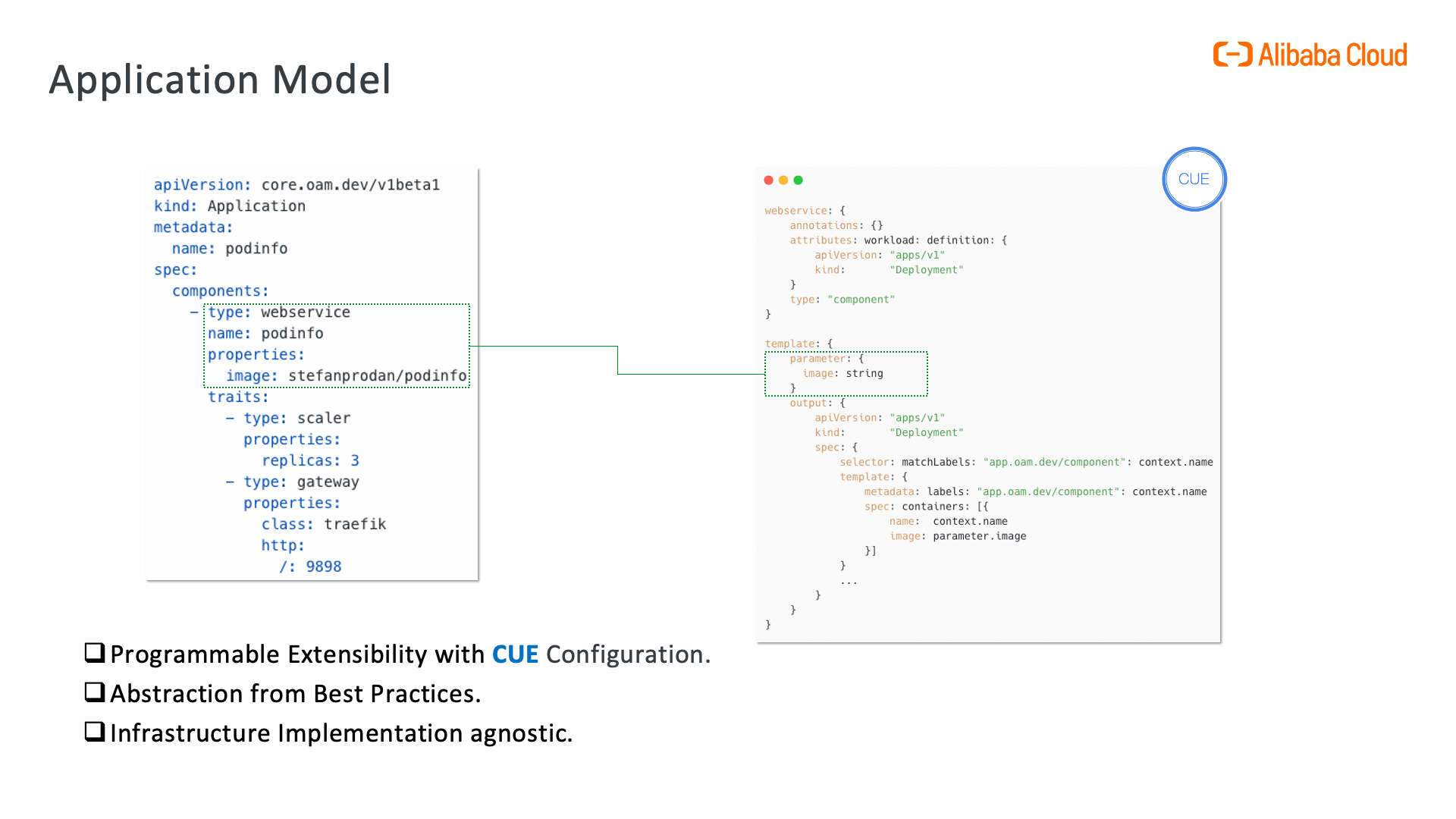
To achieve that, best practices of using Kubernetes native resources are summarized into KubeVela X-Definitions, which provide rendering templates of resources using CUE. These templates can be accessed from various sources, including official repositories, community addons or even self customized implementations by system operators. The templates are mostly infrastructure implemetation agnostic, in other words, not necessarily bond to specific infrastructures. The developers do not need to be aware of the underlying infra when using these templates.
The application model divides the abstraction of infra into two different aspects. The Component describes the main workload, which particularly in Kubernetes can be Deployments, StatefulSets, Helm Releases, etc. The Trait on the other hands, describes the added capability for the main workload, such as the scaler trait specifying the number of replicas and the gateway trait aggregates the endpoints for access. The separation of concerns in the design of Component and Trait give high extensibility and reusability to the abstraction.
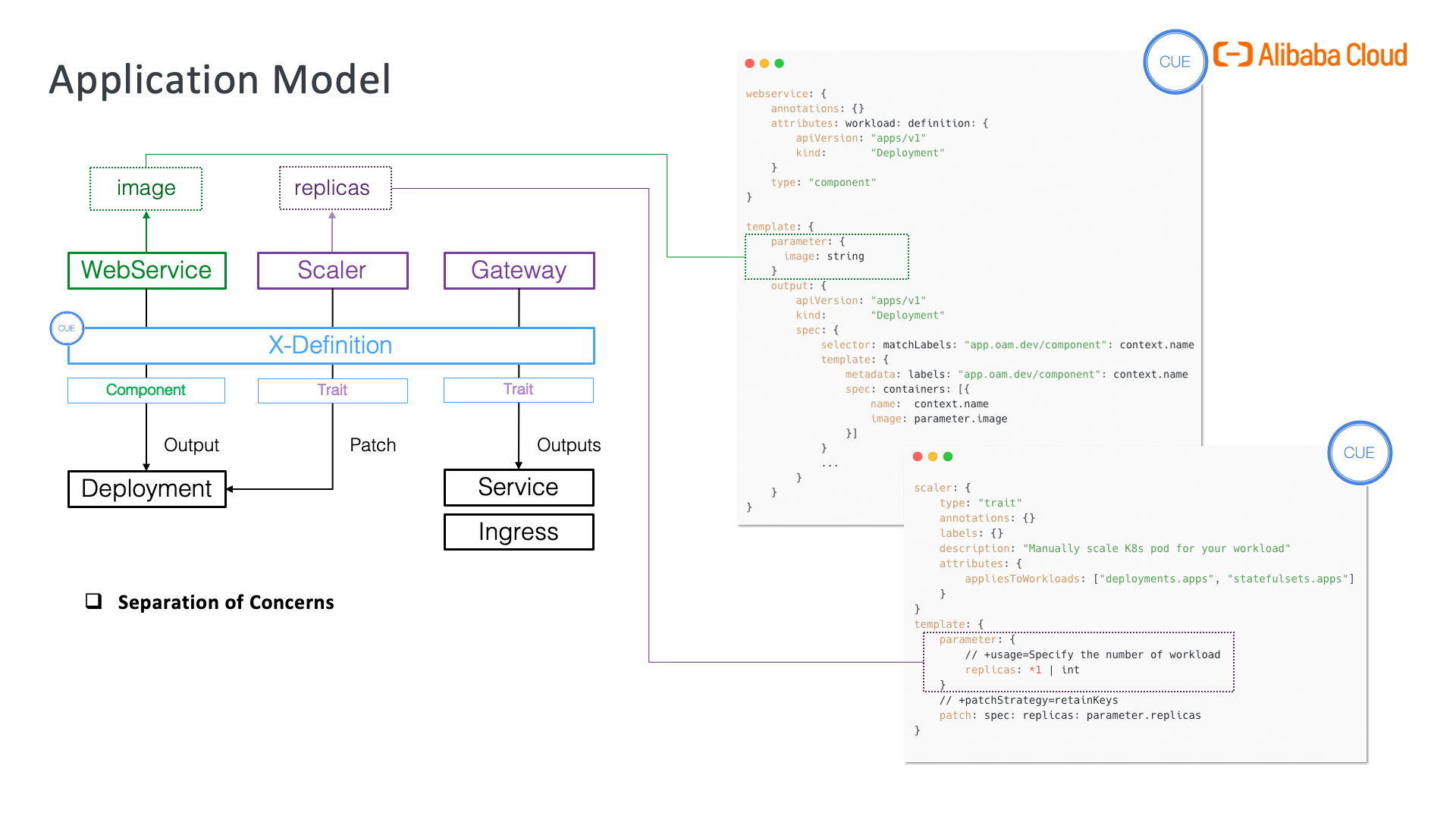
For example, the gateway trait could be backended by different infrastructures like Ingress or HTTPRoute. The application developer who uses the trait only needs to care about the exposed parameters, including the path, port and domain. The trait can be attached to various types of workloads, abstracted by different types of components, such as Deployment, StatefulSet, CloneSet, etc.
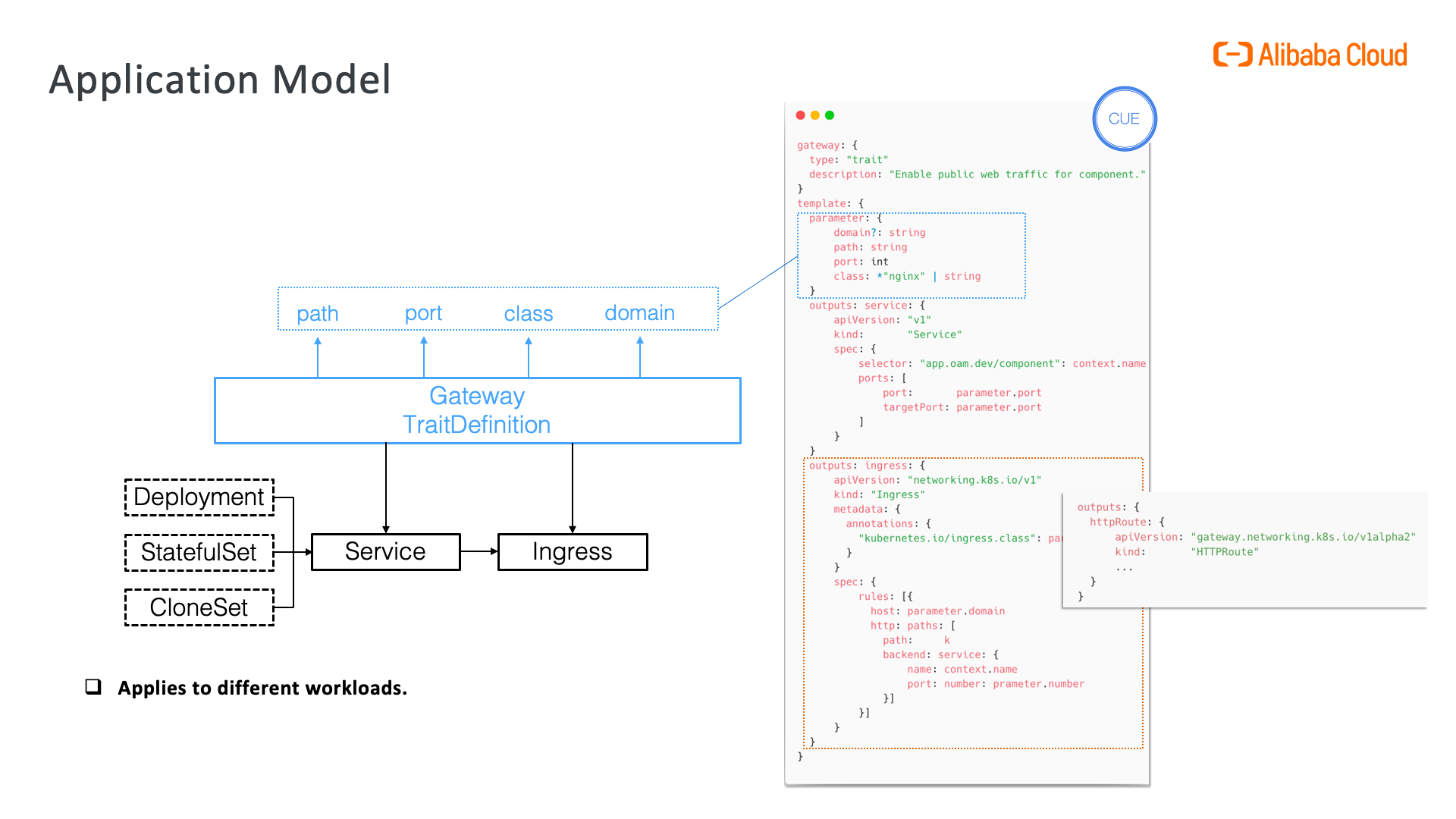
In the cases where application developers and SRE are in the different teams, KubeVela makes clear division for their responsibilities.
These are made possible thanks to the flexible, extensible and programmable system of KubeVela and can be applied under varying environments.
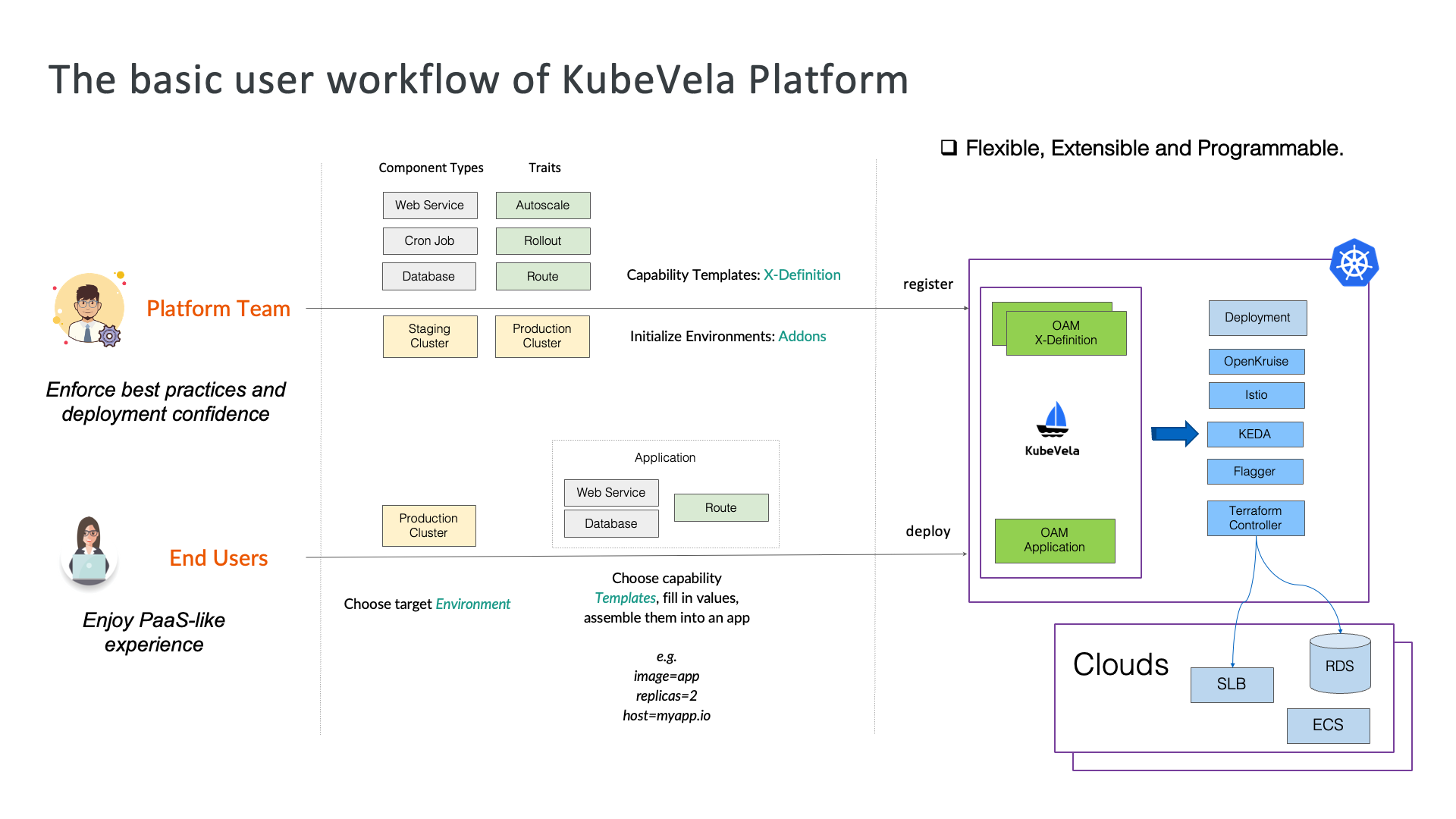
Application delivery could happen everywhere. Therefore, another goal for KubeVela application is to build up unified delivery and provide consistent usage for users under various scenarios.
In addition to the abstraction layer, KubeVela also supports hybrid-cloud or multi-cluster architecture natively as modern cloud native applications are not only about containers but involves lots of cloud resources as well. Besides, more and more users and teams start facing the difficulties of deliverying applications to various environments or multi-clusters for different purposes, such as testing or high availability.
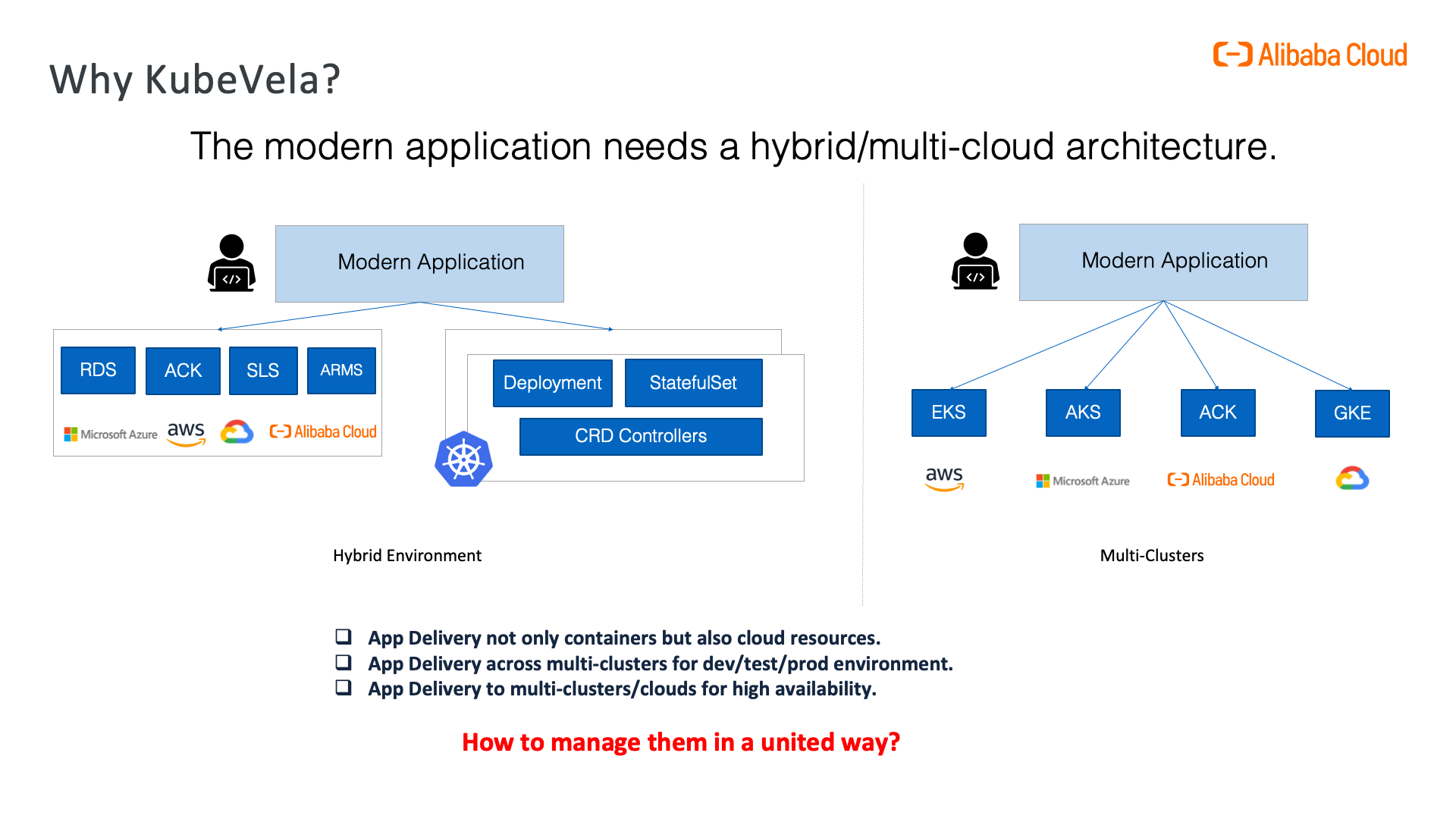
The KubeVela application allows user to define delivery targets and differentiated configurations through policies. The abstraction helps hide the details of how clusters are registered and connected and provide runtime-agnostic usages to app developers.
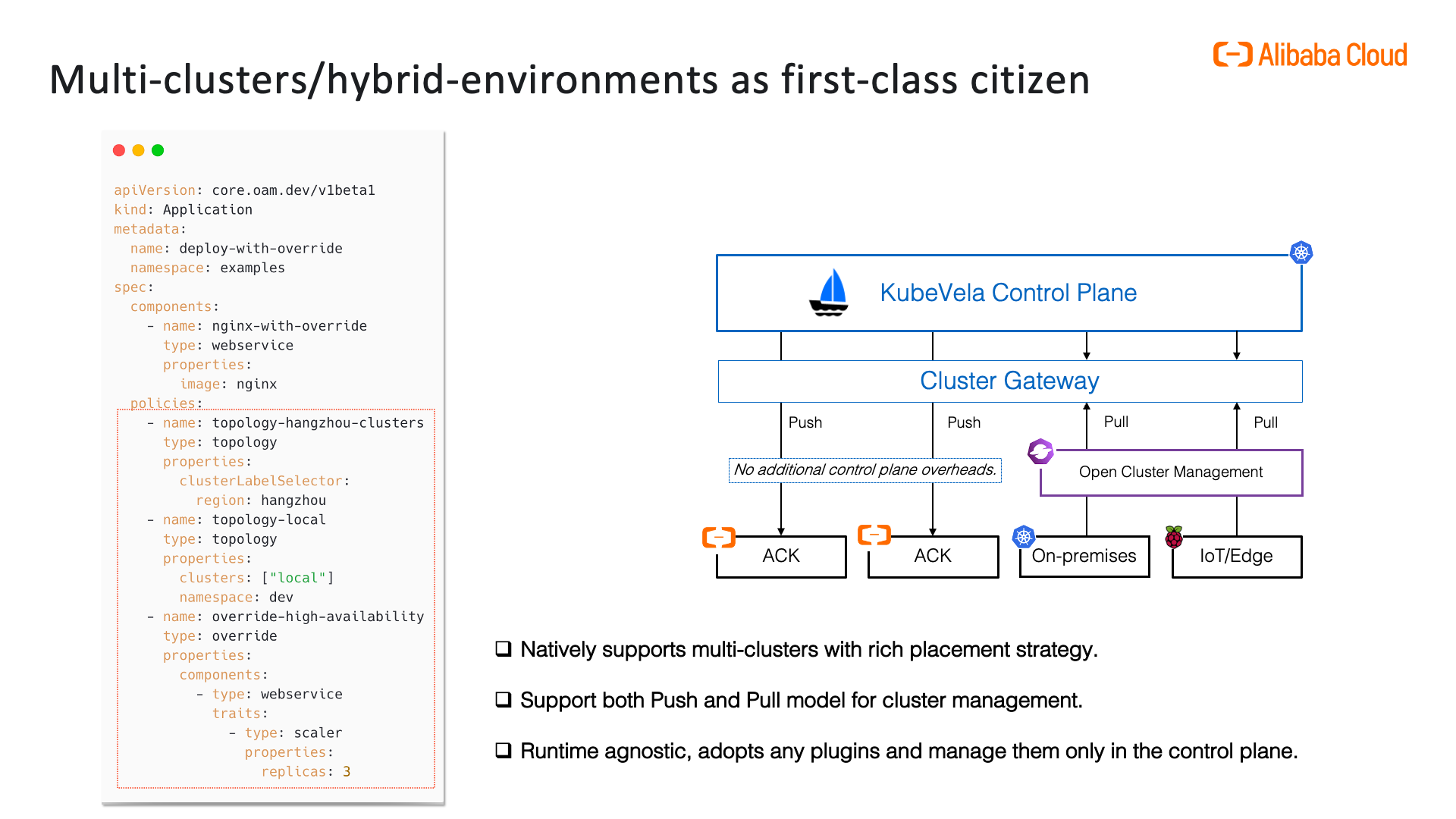
To enrich the delivery capability, users can leverage KubeVela addons to make extensions to their system. The addons are discoverable, reusable and easy-to-install capability bundles. They usually contain capability providers, including a wide range of third-party projects, like FluxCD, ClickHouse, Crossplane, etc. Addons not only install those projects into the system but create corresponding definitions for the integration concurrently, which extends the types of Component and Trait that application developers are able to use. The KubeVela community currently have 50+ addons already. Platform builders could enjoy these out-of-box integrations in systems depending on their customized demands.
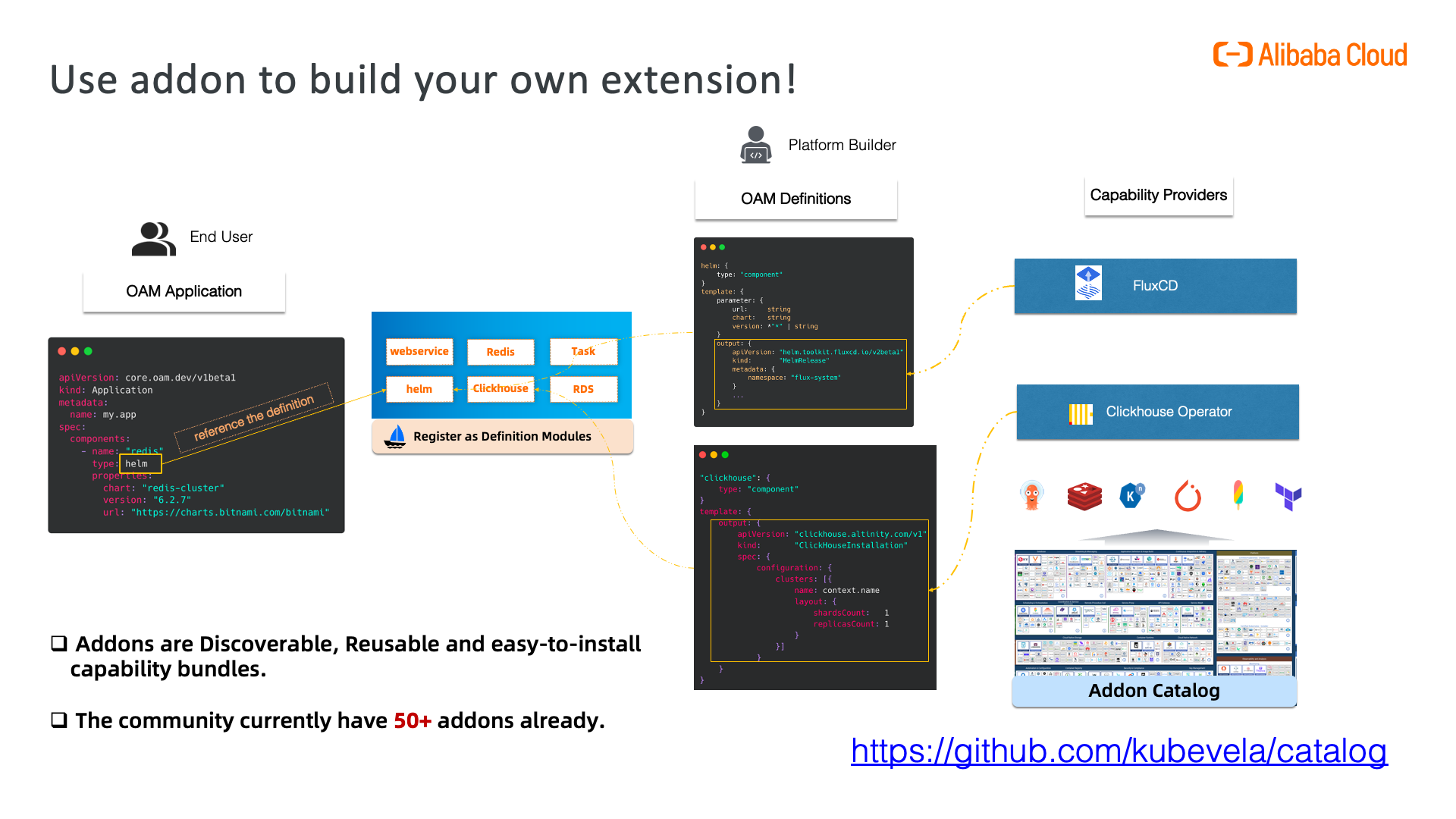
With addons enabled in the system, it would be possible for end users to assemble applications in more customized ways, such as deploying cloud resources or using advanced workloads.
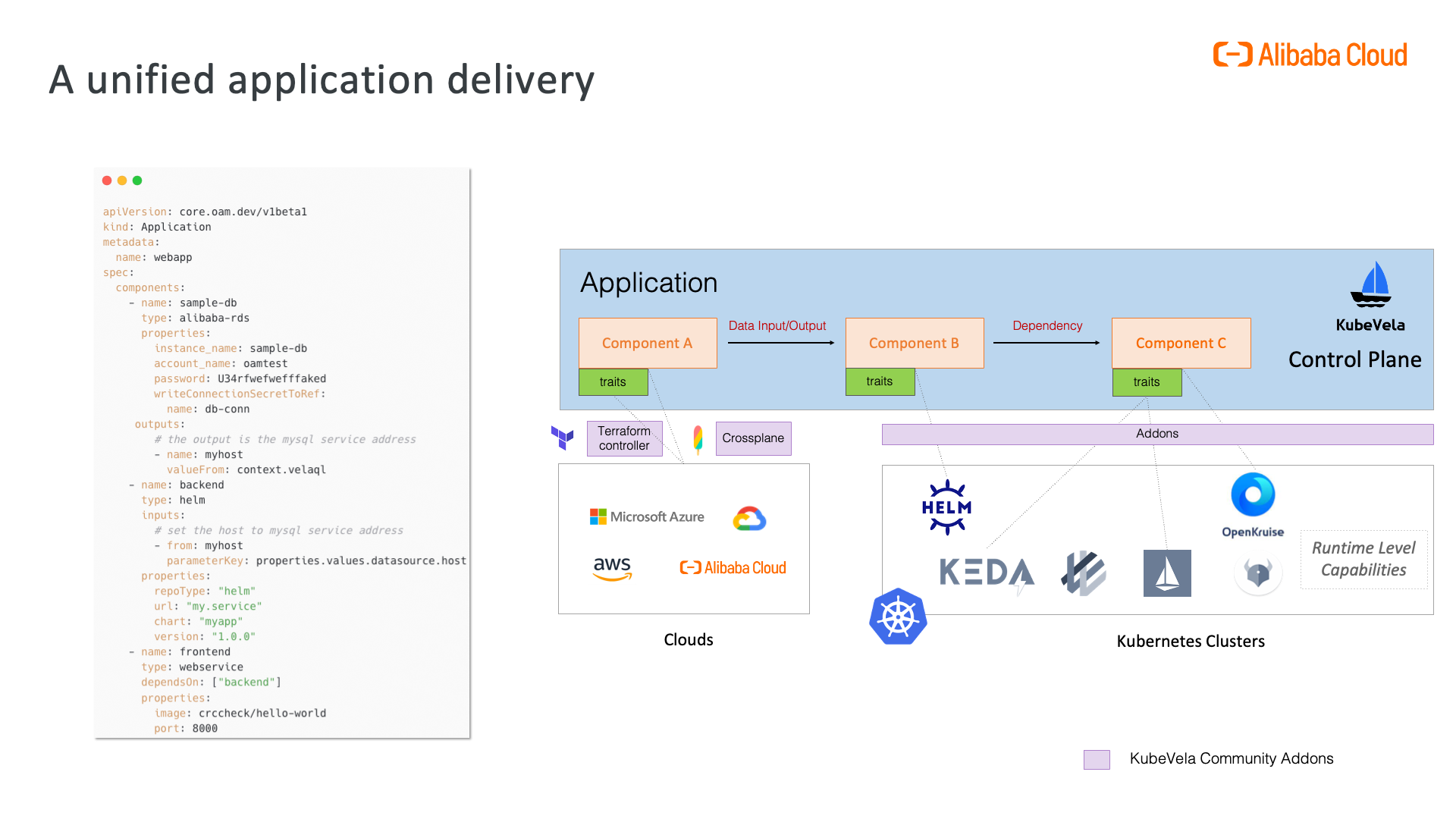
While the Open Application Model defines the composition of an application, in real cases, the delivery process of the compositions could still vary a lot. For example, the different components in one application could have inter dependencies or data passing where delivery steps must be executed in specific order. Furthermore, the delivery process sometimes also involves more actions apart from the delivery of resources, such as rollouts or notifications. An extensible workflow is therefore designed to fulfill the needs of the process customization in KubeVela.
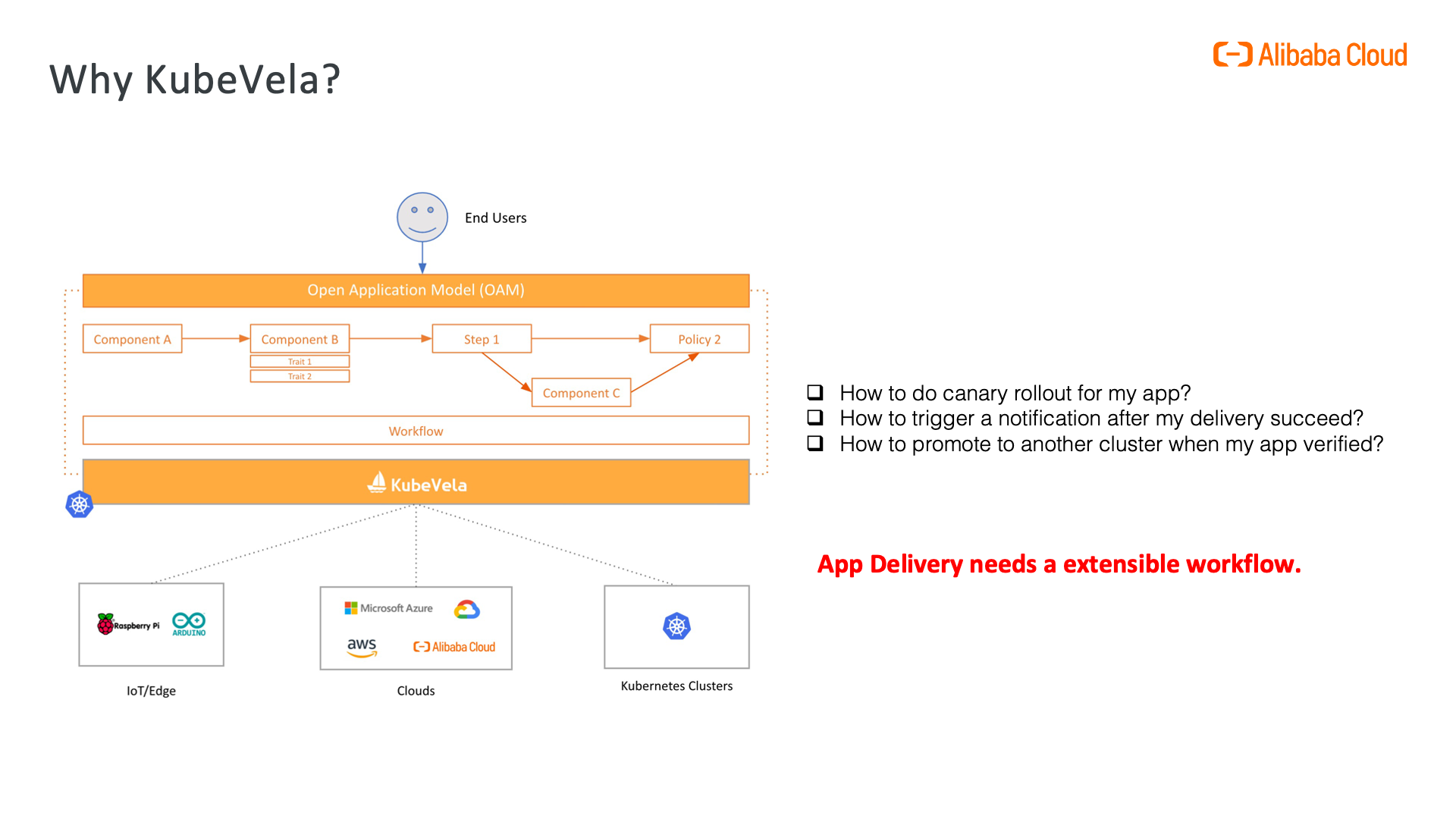
Similar to Component and Trait, KubeVela workflow also leverages CUE to define workflow steps, providing flexibility, extensibility and programmability. It can be seen as another form of Infrastructure as Code (IaC). A bunch of build-in workflow steps has already provided rich out-of-box capabilities in KubeVela, such as making multi-cluster deployments and sending notifications through slack or email. The lightweight engine ensures the high performance and safety of step executions, compared to other types of engines involving running extra containers.
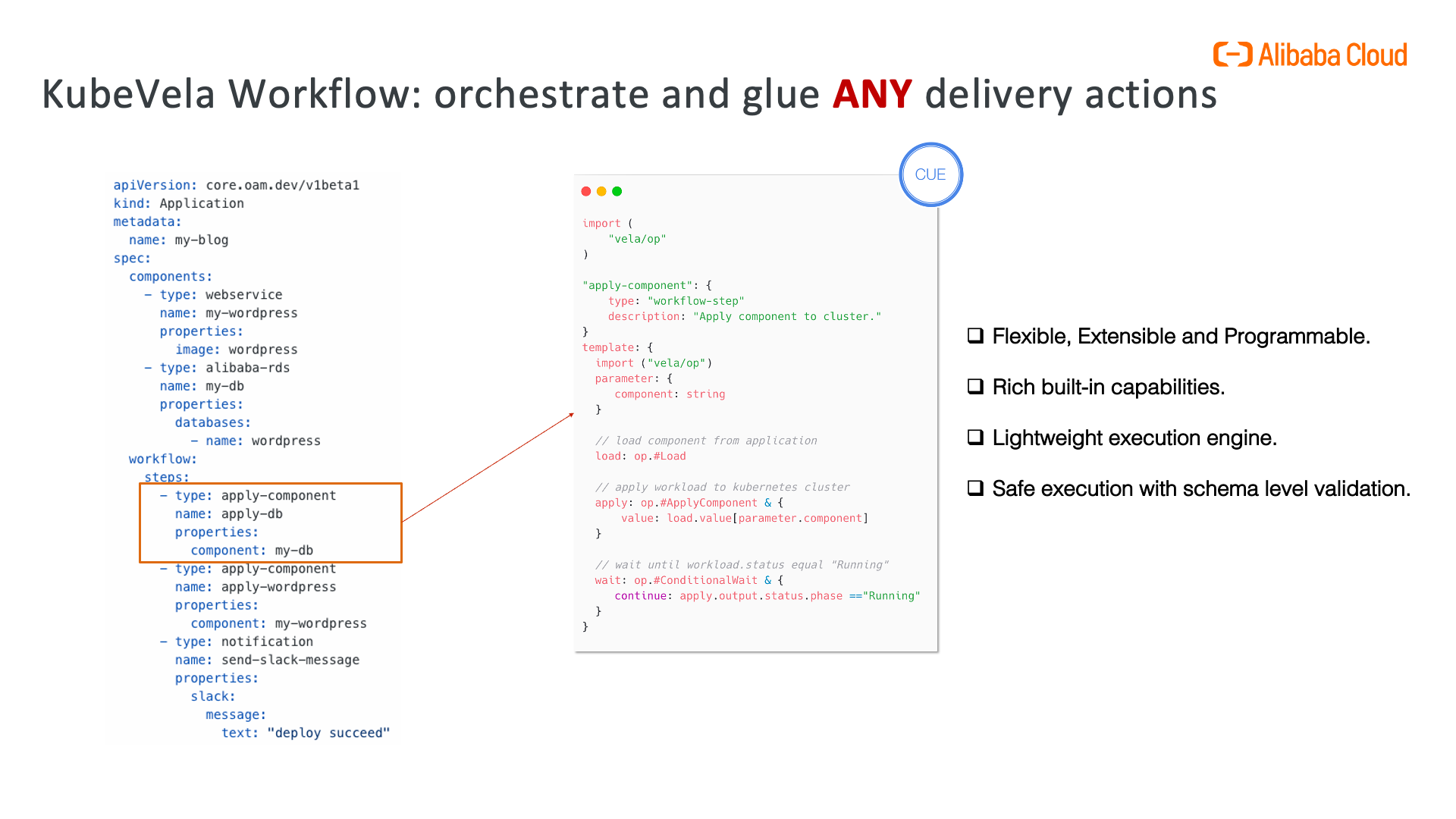
Differ from the Component and Trait definitions in KubeVela, the WorkflowStep definition does not render templates into resources. Instead, it describes the actions to be executed in the step, which calls underlying atomic functions in various providers.
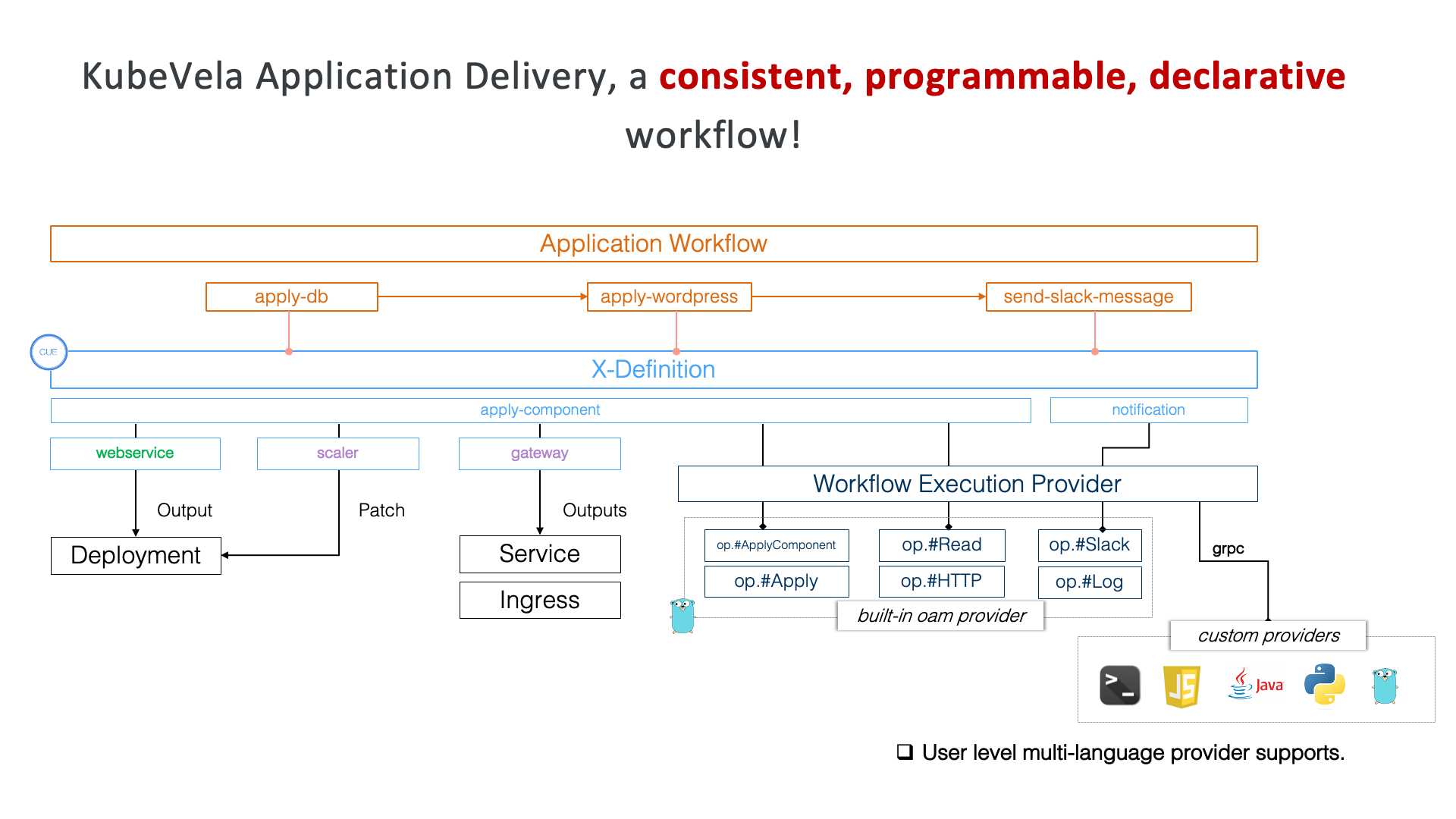
With the use of workflow and addons, users are able to build arbitrary delivery process and make customized integrations. For example, it is possible to let the Continuous Integration tools to trigger the delivery of KubeVela applications and implement the GitOps solutions combining FluxCD and other addons.
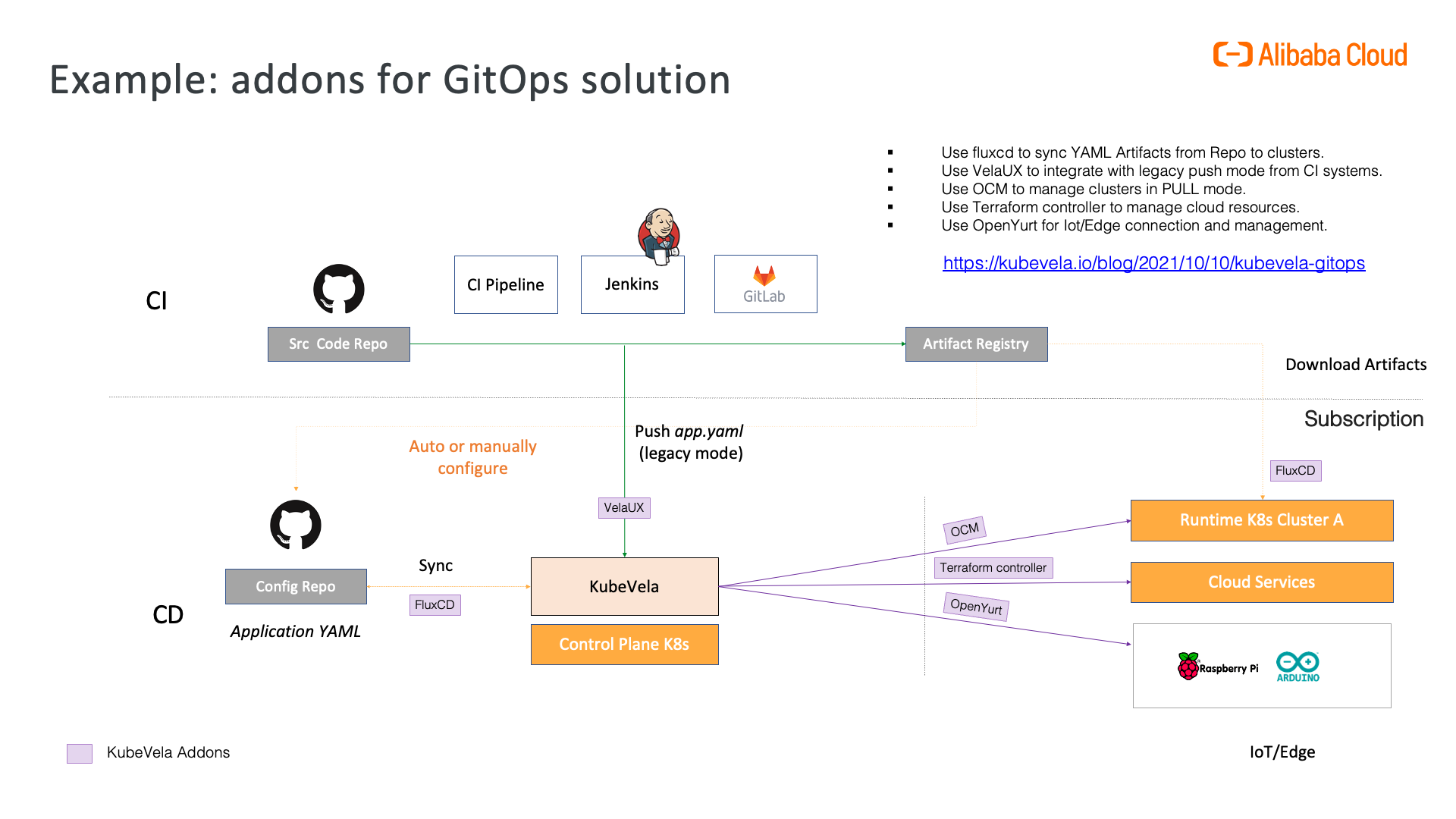
KubeVela cares more other than Day-1 Delivery. It also provides a unified Day-2 application management capability for all it's extensibility. The day-2 management is necessary for system operators and application developers to make continuous operation for the delivered applications and ensure the applications are always under control.
The basic capabilities for application management are for its resources. KubeVela's core controller continuously watches the difference between the current state and the desired state of delivered resources. It makes sure that the live spec is accord with the declared spec recorded in the delivery process and therefore effectively prevents any configuration drifts.
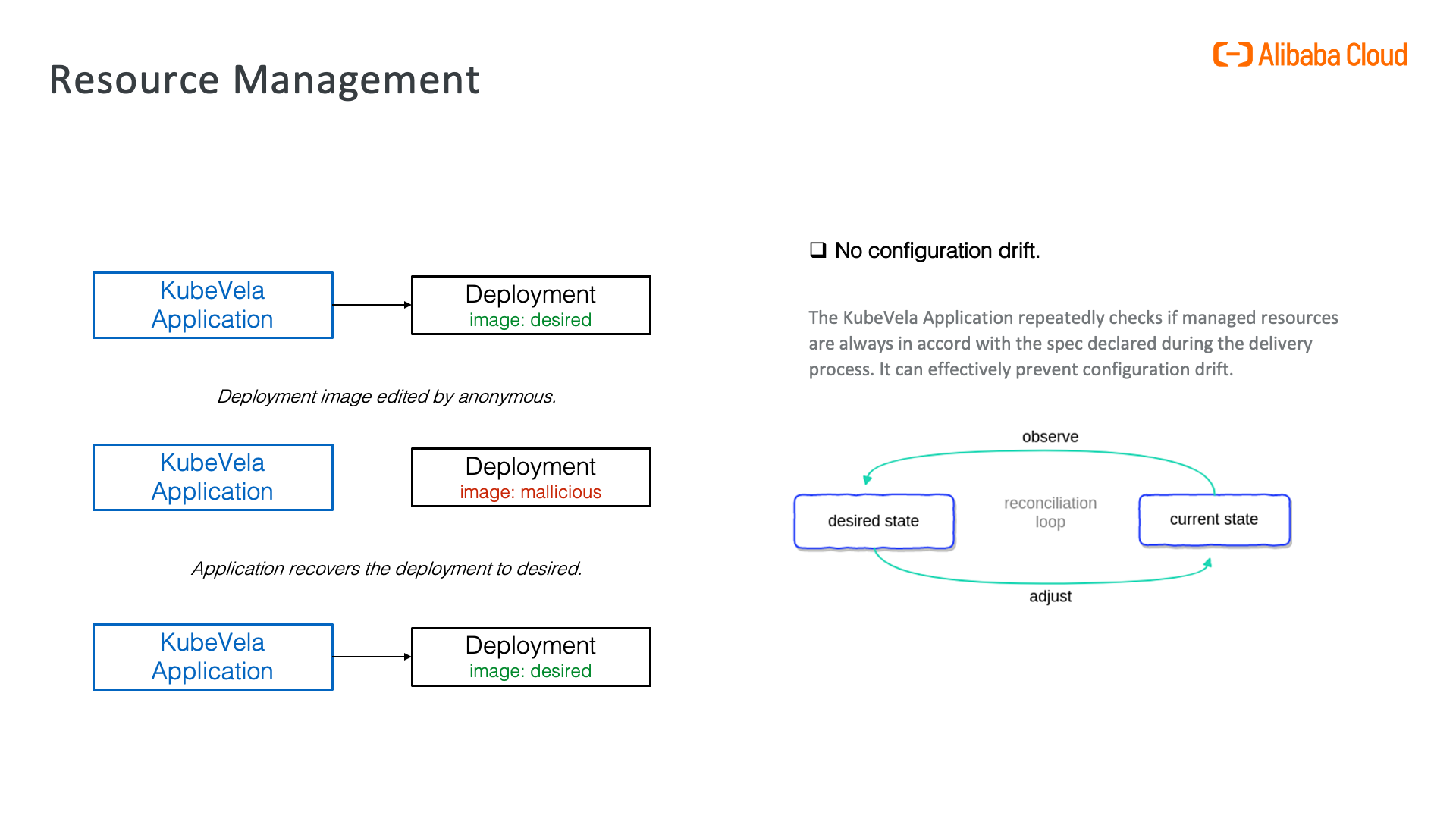
Besides, the automated garbage collection help recycle the resources that are not in-use during upgrades or deletion. There are also times resources need to be shared across multiple applications. These are all made possible in KubeVela application through the use of policies.
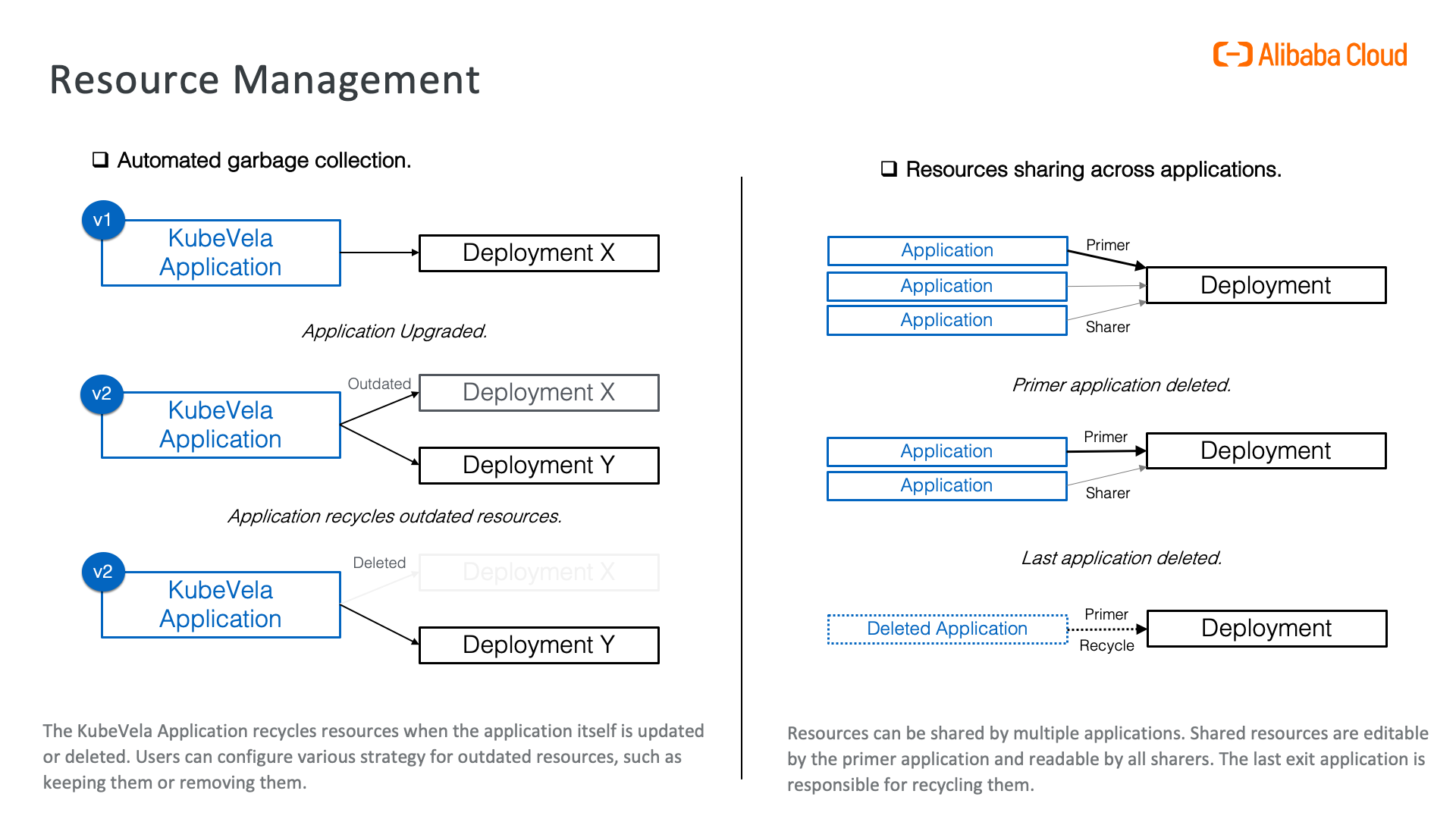
KubeVela application keeps history records for deliveries. These snapshots are useful when new version publish are out of expectations. The change inspectation could be used to diagnose the possible error changes and the rollback allows fast recovery to the previous successful states.
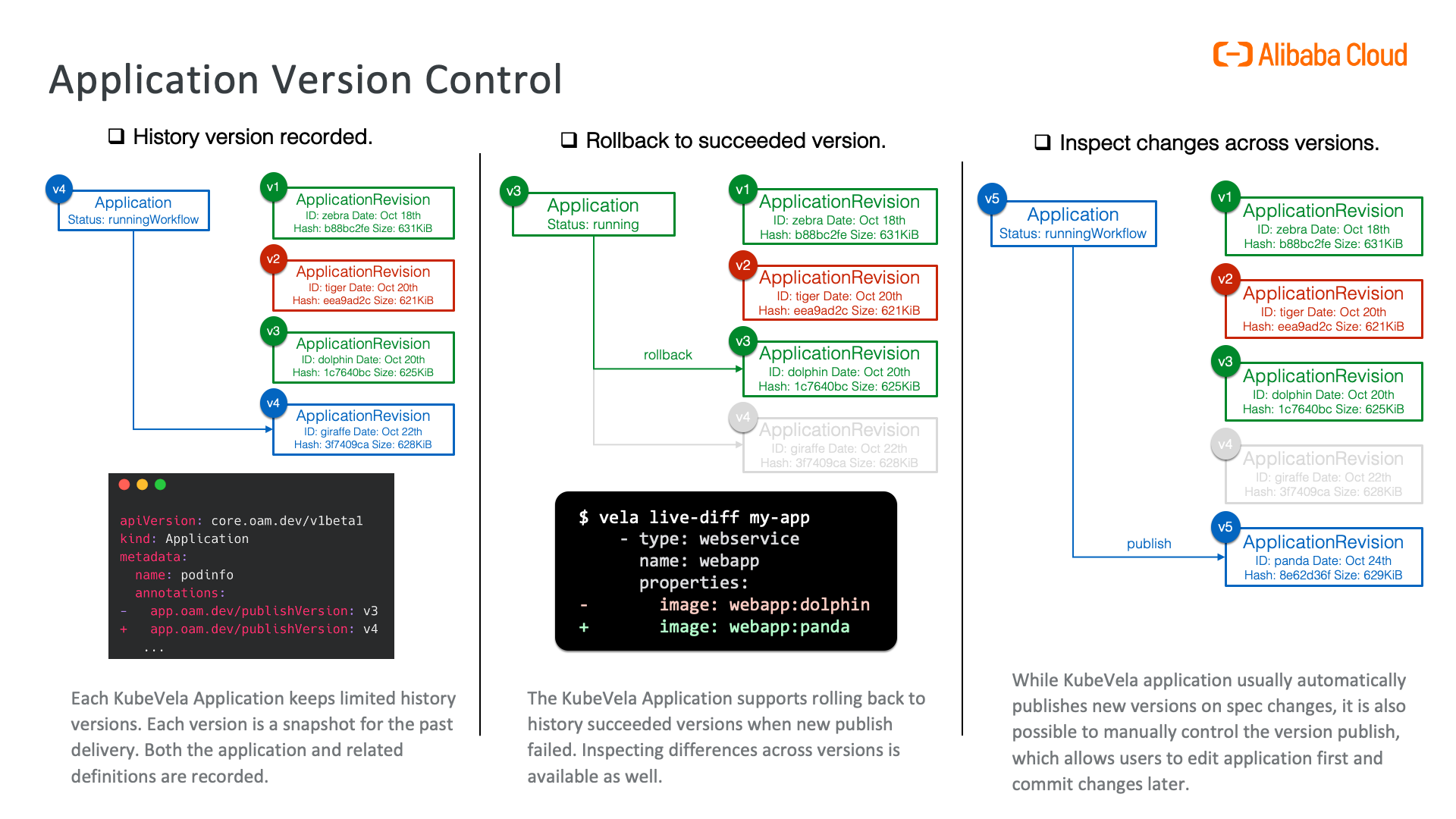
KubeVela treats observability as first class citizen. It is the eyes to users for monitoring the state of applications and observing exceptions. There are multiple tools and methods in KubeVela to do the observation job. One of the most straightforward way is to use the CLI tool of KubeVela. The Vela CLI is able to provide in-time status info for the application in fine-grain or aggregated level.
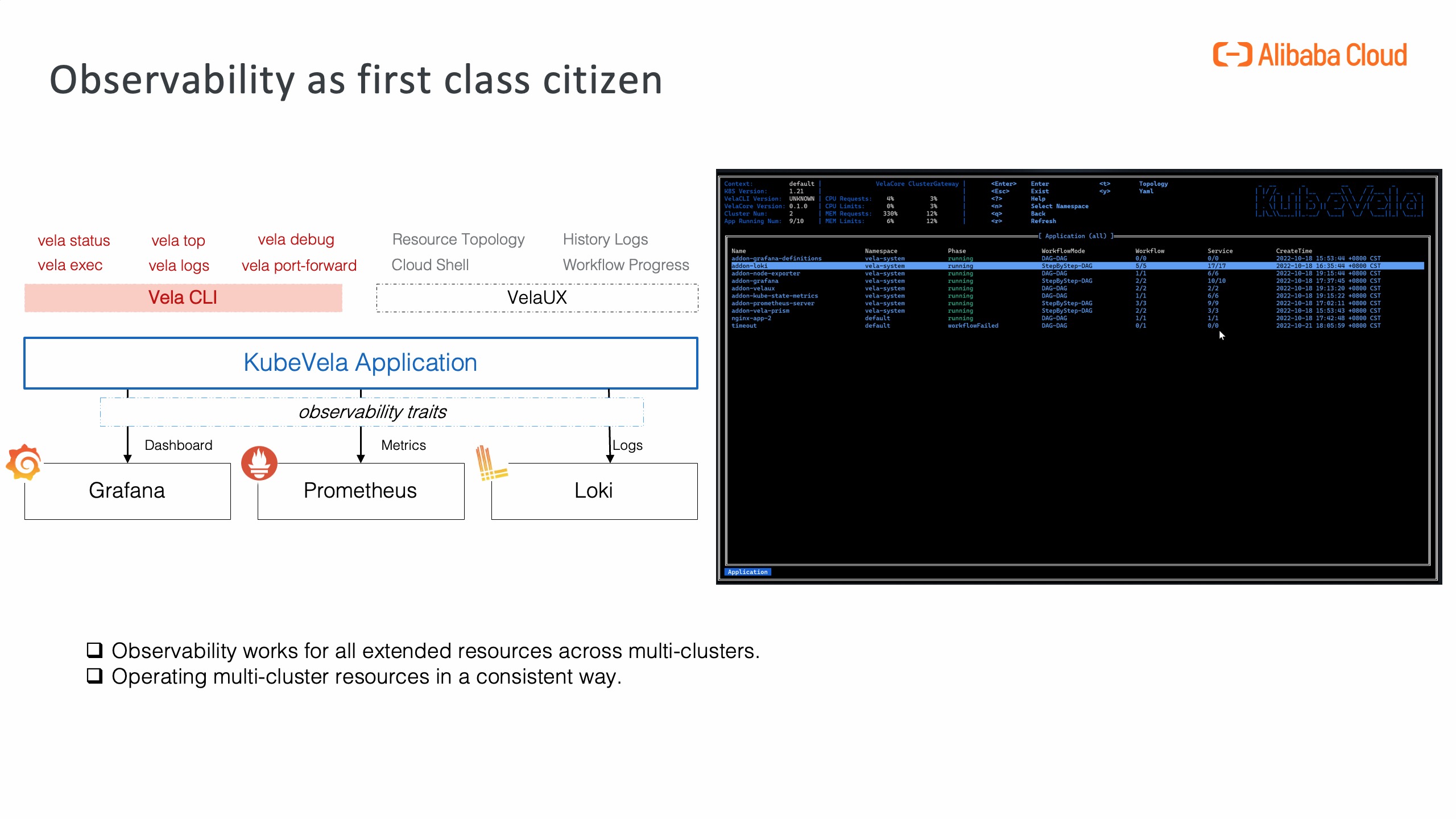
For users that prefer web interfaces, VelaUX provides an alternative way to view application status.
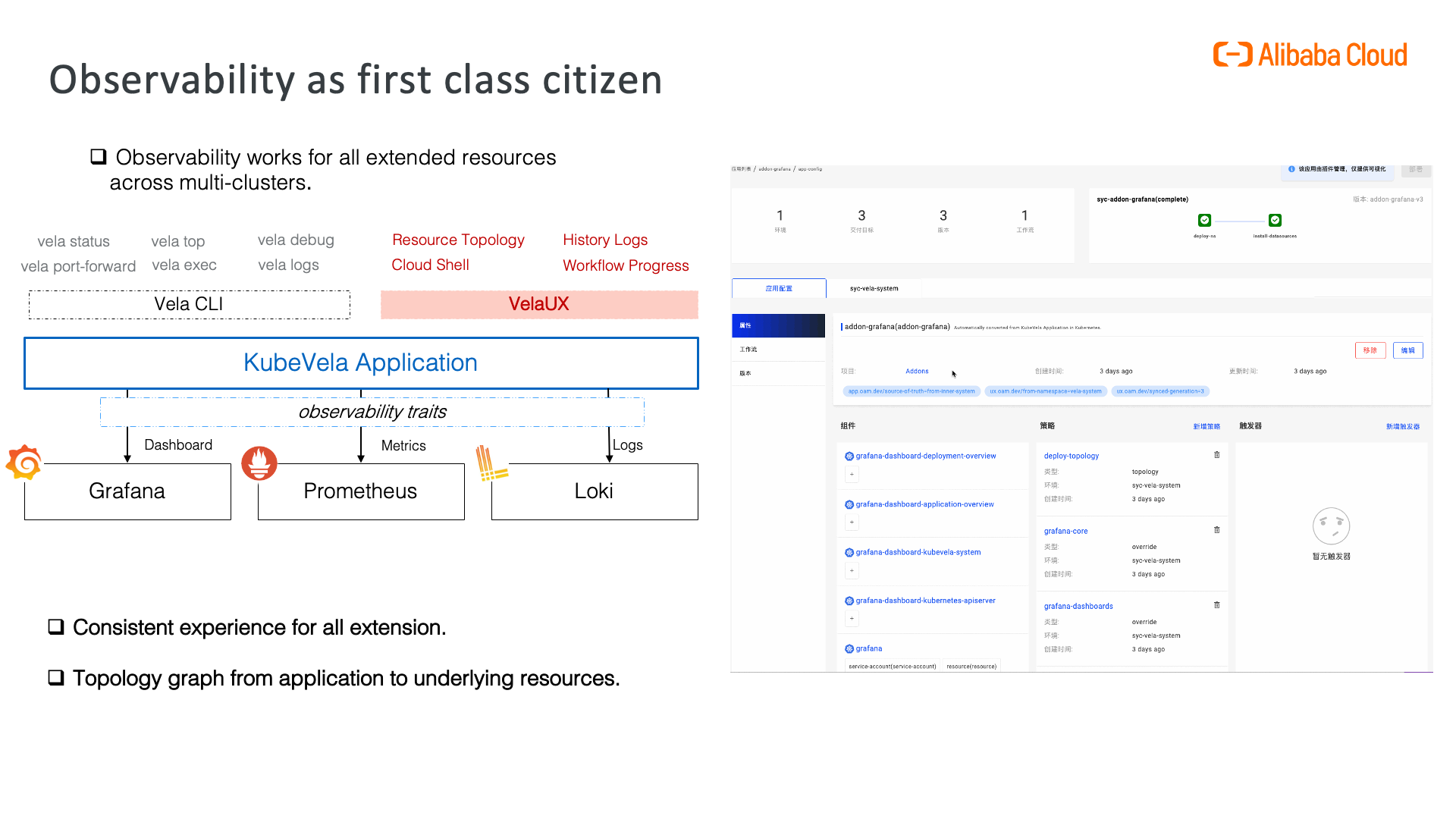
In the cases applications are monitored through third-party projects, such as Grafana, Prometheus or Loki, KubeVela further provides addons for bootstrapping the observability infrastructures and empower users to customize the observing rules as codes in applications, through the abstraction layer.
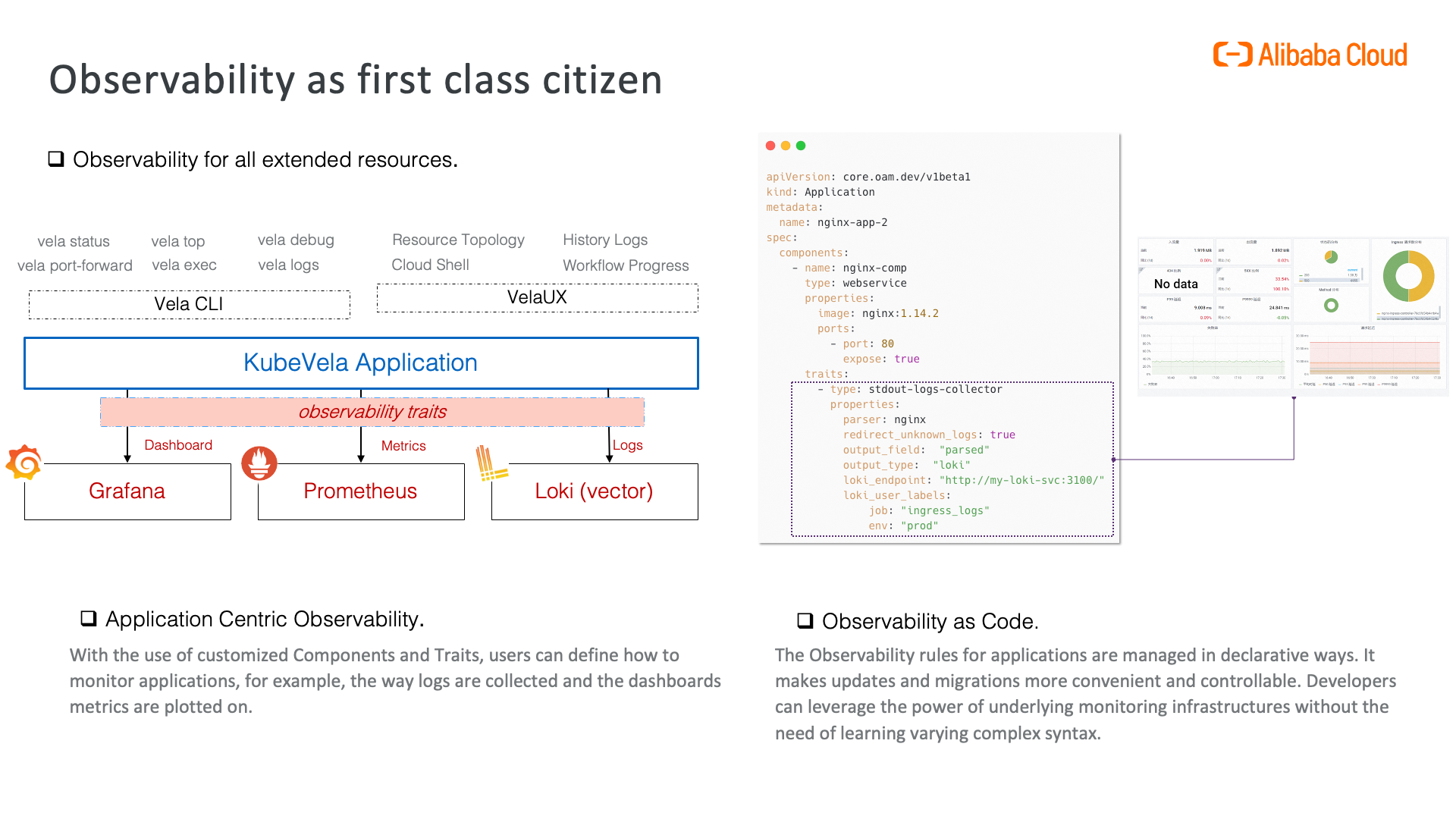
A series of out-of-box metrics and dashboards give users the basic capability of automated system observability. These can be used to diagnose system level exceptions and help improve the overall performance.
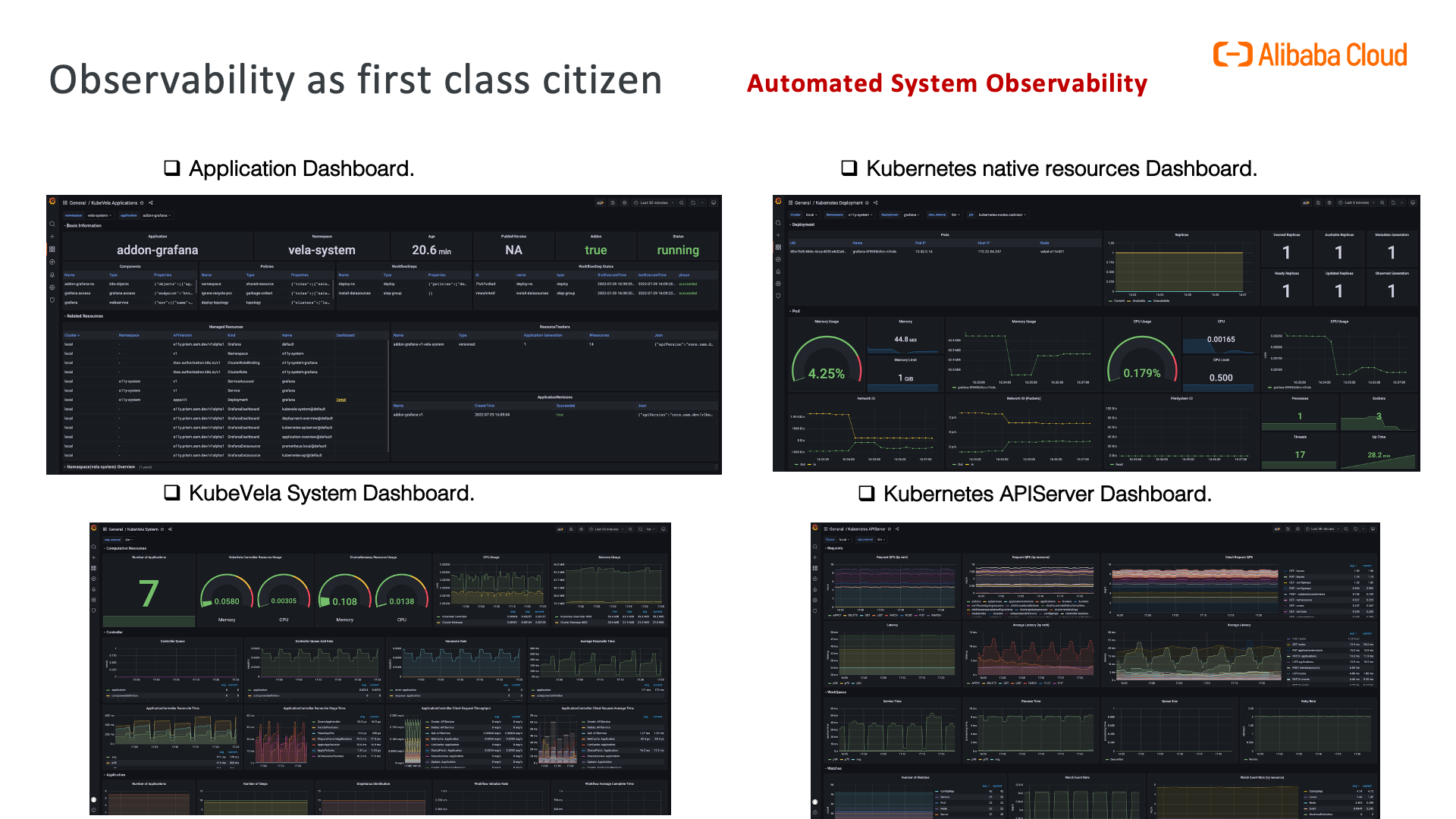
In addition to the above mentioned tools, KubeVela also has several other tools in the eco-systems to facilitate application delivery.
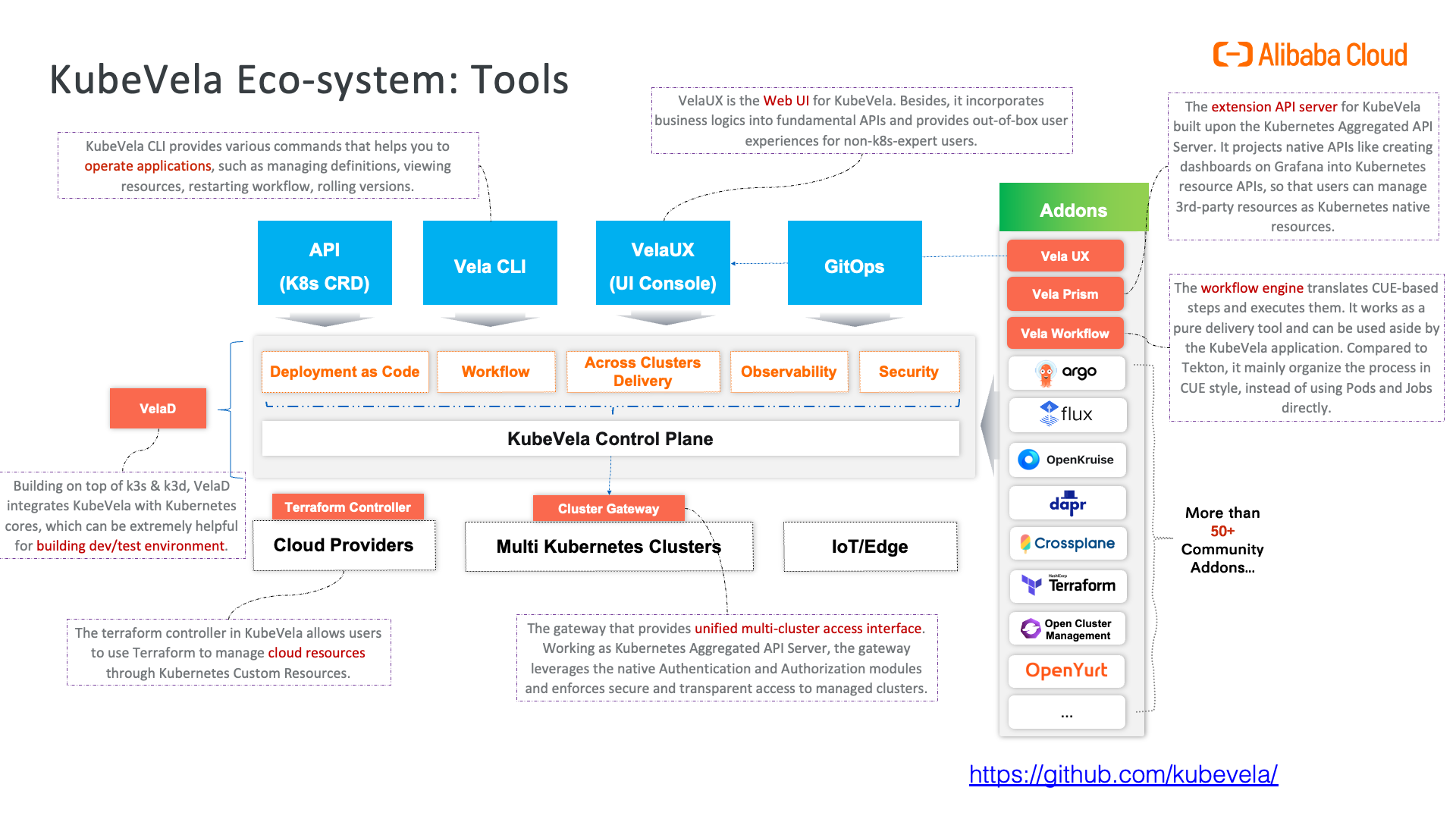
To ensure KubeVela is able to handle certain amount of applications under limited resources, multiple load testings have been conducted under various circumstances. The experiments have demonstrated that the performance of KubeVela system is capable of dealing thousands of applications in an ordinary-sized cluster. The observability infrastructure further exposes the bottleneck of KubeVela and guides system operators to do customized tunning to improve the performance in specific use environments.
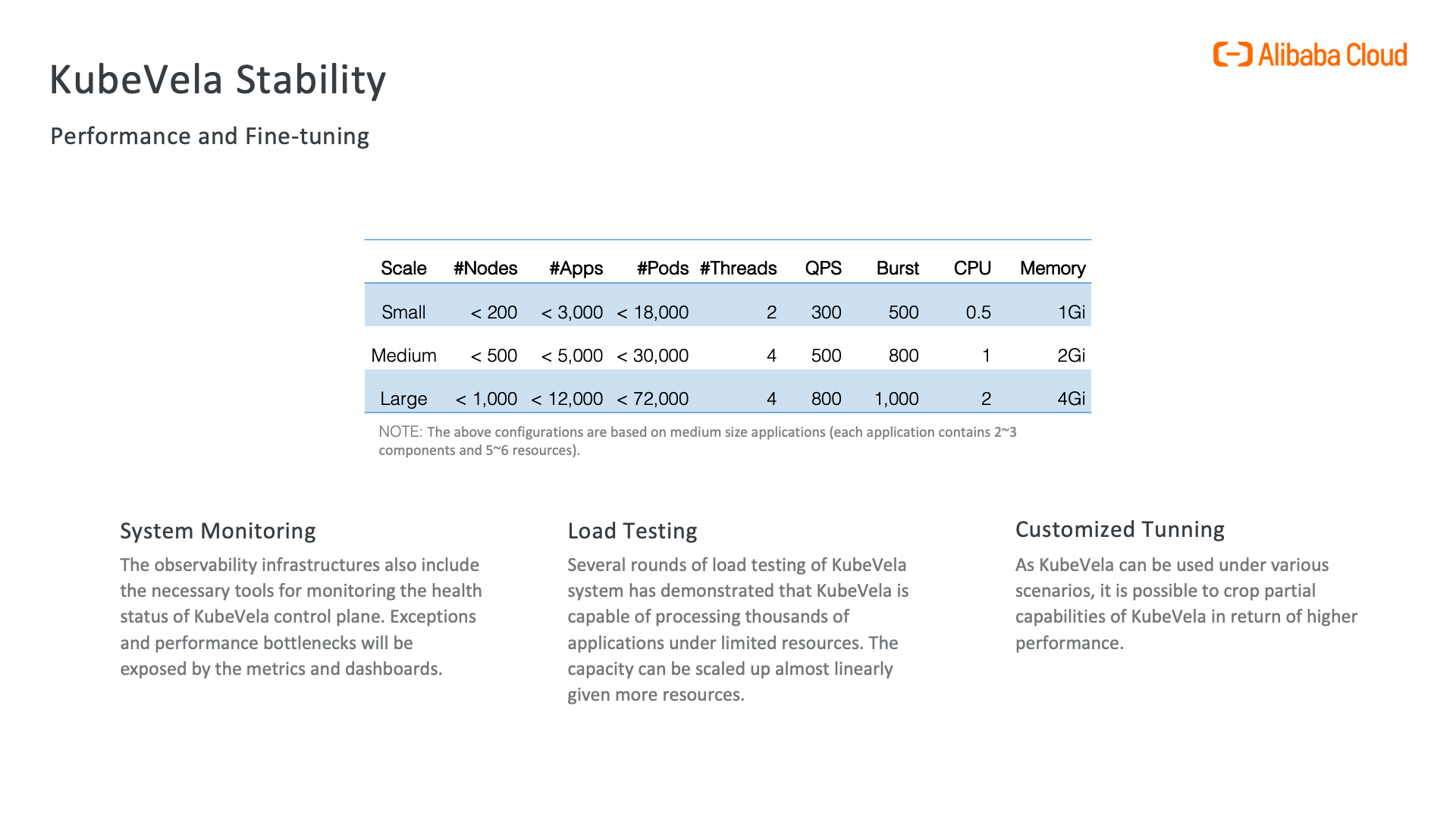
Currently, KubeVela has already been applied in production by a number of adopters from various areas. Some mainly use KubeVela's abstraction capability to simplify the use and deploy of applications. Some build application-centric management system upon KubeVela. Some use the customized workflow to orchestrate the delivery process. It is especially welcomed in high-tech industries and shown to be helpful for delivering and managing enourmous applications.

The KubeVela community has attracted world-wide contributors and continuously evolves over the past two years. Nowadays, there are over 200 contributors from various contries have participated in the developing of KubeVela. Thousands of issues have been raised and 85% of them are already solved. There are also bi-weekly community meetings held in both English and Chinese community.

With more and more people coming into the community, KubeVela is consistently upgrading itself to fit into more complex, varying use cases and scenarios.
Use Transactional Messages to Understand RocketMQ Service Messages
How to Migrate Existing Terraform Cloud Resources to KubeVela

514 posts | 50 followers
FollowAlibaba Cloud Community - February 10, 2023
Alibaba Cloud Native Community - February 9, 2023
Alibaba Cloud Native Community - January 9, 2023
Alibaba Cloud Native Community - February 9, 2023
Alibaba Cloud Native Community - November 11, 2022
Alibaba Cloud Native Community - March 8, 2023

514 posts | 50 followers
Follow Cloud-Native Applications Management Solution
Cloud-Native Applications Management Solution
Accelerate and secure the development, deployment, and management of containerized applications cost-effectively.
Learn More Function Compute
Function Compute
Alibaba Cloud Function Compute is a fully-managed event-driven compute service. It allows you to focus on writing and uploading code without the need to manage infrastructure such as servers.
Learn More Alibaba Cloud Flow
Alibaba Cloud Flow
An enterprise-level continuous delivery tool.
Learn More DevOps Solution
DevOps Solution
Accelerate software development and delivery by integrating DevOps with the cloud
Learn MoreMore Posts by Alibaba Cloud Native Community
Tran Phuc Hau April 10, 2023 at 1:47 am
I got this error when runningvela port-forward -n vela-system addon-velaux 9082:80? There are 2 services match your filter conditions. Please choose one:Cluster | Component | Service local | velaux | velauxtrying to connect the remote endpoint svc/velaux 9082:80 ..Forwarding from 127.0.0.1:9082 -> 80Forwarding from [::1]:9082 -> 80Forward successfully! Opening browser ...Failed to open browser: exec: "xdg-open": executable file not found in $PATH
Alibaba Cloud Community April 10, 2023 at 6:03 am
Thanks for reporting this error, you can raise it as KubeVela issue( https://github.com/kubevela/kubevela/issues ) or ask in the CNCF